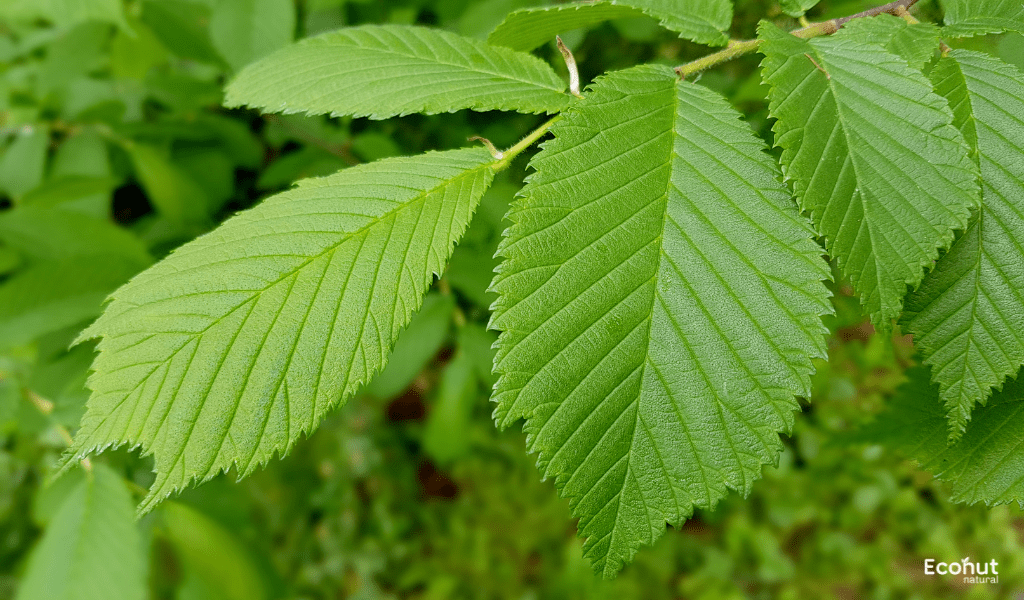Slippery Elm (Ulmas rubra) is an herbal remedy derived from the inner bark of the slippery elm tree, scientifically known as Ulmus rubra. Ulmus rubra, the slippery elm, is a species of elm native to eastern North America.
Slippery Elm (Ulmas rubra) Description
Ulmus rubra is a medium-sized deciduous tree with a spreading head of branches, commonly growing to 12–19 metres (39–62 feet), very occasionally over 30 m (98 ft) in height. Its heartwood is reddish-brown. The broad oblong to obovate leaves are 10–20 centimetres (4–8 inches) long, rough above but velvety below, with coarse double-serrate margins, acuminate apices and oblique bases; the petioles are 6–12 millimetres (1⁄4–15⁄32 in) long.
The leaves are often tinged red on emergence, turning dark green by summer and a dull yellow in autumn. The perfect, apetalous, wind-pollinated flowers are produced before the leaves in early spring, usually in tight, short-stalked, clusters of 10–20.
The reddish-brown fruit is an oval winged samara, orbicular to obovate, slightly notched at the top, 12–18 mm (15⁄32–23⁄32 in) long, the single, central seed coated with red-brown hairs, naked elsewhere.
Slippery Elm (Ulmas rubra) Other Names
- Moose Elm
- Winged Elm
- Sweet Elm
- Red Elm
- Indian Elm
- Gray Elm
- Ulmus Fulva
Slippery Elm Scientific Classification
| Kingdom | Plantae |
| Order | Rosales |
| Family | Ulmaceae |
| Genus | Ulmus |
| Binomial Name | Ulmus rubra |
Benefits of Slippery Elm (Ulmas rubra)
Slippery elm, scientifically known as Ulmus rubra, is a tree native to North America. It has been used for centuries in traditional medicine, particularly by Native American tribes. Here, We discuss some benefits of slippery elm.
Soothes Sore Throat and Cough:
Slippery elm has demulcent properties, meaning it forms a soothing film when it comes in contact with mucous membranes. This can help relieve throat irritation and dry coughs.
Useful for Weight Loss:
Some weight loss supplements include slippery elm due to its potential to create a feeling of fullness, which might help with appetite control.
Using In Skin Care:
Some people use slippery elm in skin creams or ointments to help soothe the symptoms of eczema and psoriasis. Again, the mucilage provides a protective barrier and may reduce inflammation.
Nutrient Absorption:
Slippery elm may help improve the absorption of certain nutrients in the gut due to its soothing and protective properties.
Slippery elm Use For Respiratory Health:
It’s sometimes used in teas or lozenges for respiratory conditions like bronchitis or asthma, helping to soothe irritated airways.
Inflammatory Bowel Diseases:
Slippery elm bark is a demulcent. This means that it is capable of soothing the lining of the stomach and intestines and reducing irritation. Demulcents are sometimes referred to as mucoprotective agents.
Eases Digestive Issues:
Slippery elm is often used to help ease symptoms of digestive conditions like acid reflux, gastritis, and ulcers. The mucilage coats the stomach and intestines, potentially providing relief from irritation.
The mucilage in slippery elm can also help bulk up stool and soothe inflamed intestines, which may be beneficial for both diarrhea and constipation.
Supports Wound Healing:
When applied topically, slippery elm may help in wound healing. The mucilage forms a protective layer over the skin, helping to keep the wound moist and promoting healing.
Some weight loss supplements include slippery elm due to its potential to create a feeling of fullness, which might help with appetite control.
Also Read: Agnimantha (Clerodendrum Phlomidis)
Slippery Elm (Ulmas rubra) Side Effects
Slippery elm, a tree native to North America, has been used for centuries for various medicinal purposes, particularly for soothing sore throats, coughs, digestive issues, and skin conditions.
While it is generally considered safe for most people when taken orally or applied topically, there can be potential side effects and interactions to be aware of. Here, We are discuss some of side effects regarding Slippery elm:
Produces Allergic Reactions:
Some peoples may be allergic to slippery elm. Signs of an allergic reaction include rash, itching, swelling (especially of the face, tongue, or throat), severe dizziness, or trouble breathing.
Gastrointestinal Distress Issues:
Slippery elm contains mucilage, a type of fiber that can swell and become gel-like when mixed with water. This property can be helpful for soothing the digestive tract, but in some cases, it may cause bloating, gas, or diarrhea.
Avoid During Pregnancy and Breastfeeding:
There is not enough reliable information about the safety of using slippery elm during pregnancy or breastfeeding. It’s best to avoid using it during these times unless under the guidance of a healthcare provider.
Effect on Blood Sugar Level:
There is some evidence to suggest that slippery elm may affect blood sugar levels. People with diabetes should monitor their blood sugar closely if taking slippery elm supplements.
Contact with Drug:
Slippery elm could potentially interfere with the absorption of other medications. It’s advised to take it a few hours apart from other medications to avoid this potential interaction.
Conclusion
Slippery elm, known for its medicinal properties, has been utilized for centuries in traditional medicine. Its inner bark contains mucilage, a gel-like substance, offering soothing effects on the digestive tract. Studies suggest it may alleviate symptoms of conditions like heartburn and irritable bowel syndrome. However, more research is needed to fully understand its efficacy and safety.
FAQS
What is Slippery Elm (Ulmas rubra)?
Slippery elm (Ulmus rubra) is a tree native to North America. The inner bark of the tree is harvested for medicinal purposes. It contains mucilage, a substance that becomes a slick gel when mixed with water.
How Does Slippery Elm (Ulmas rubra) Work?
Slippery elm’s mucilage content is thought to be responsible for many of its health benefits. When ingested, the mucilage can coat and soothe the throat and gastrointestinal tract. It may also help with drawing out toxins and other substances.
Can Slippery Elm (Ulmas rubra) Interact with Medications?
Slippery elm may slow down the absorption of medications due to its mucilage content. If you’re taking medications, especially those for diabetes or other conditions where timing and absorption are crucial, it’s best to speak with your doctor before using slippery elm.
Are There Any Side Effects of Slippery Elm (Ulmas rubra)?
Slippery elm is generally well-tolerated, but some people may experience mild side effects such as nausea or an allergic reaction. It’s always a good idea to start with a small dose and monitor how your body reacts.

